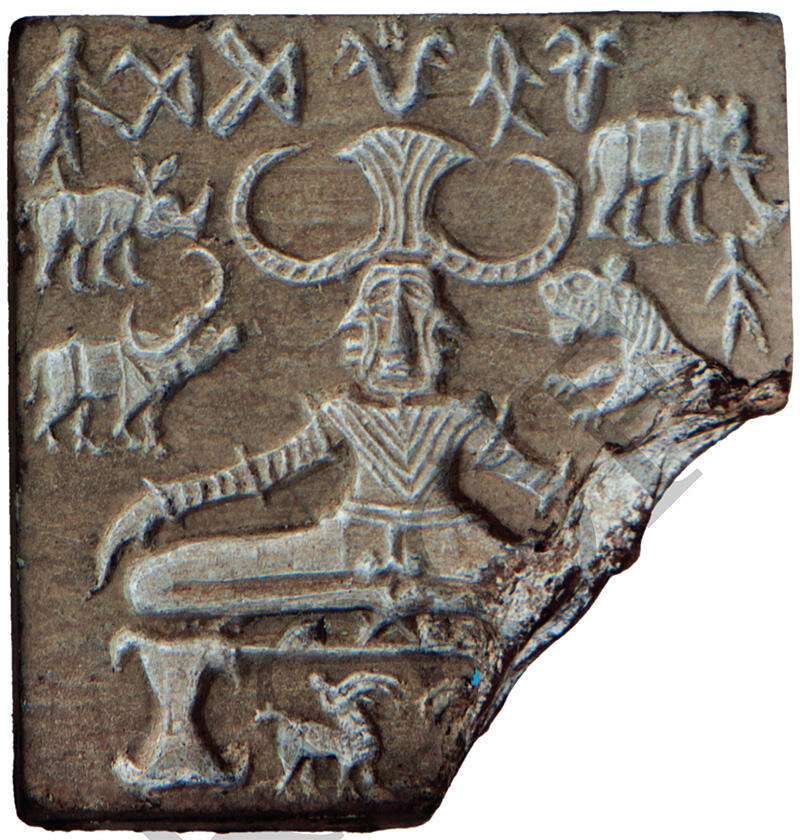Above: The famous “Proto-Shiva” seal M-304A from Mohenjo-daro. Photo Erja Lahdenperä, courtesy National Museum of India
A proof of this upcoming survey article by the dean of Indus script scholarship, Asko Parpola, is now available on Academia.edu; it will be published in the highly anticipated Seals and Sealing in the Ancient World (Cambridge, 2018). It is an excellent, detailed summary of the wide range of the information that we have on the Indus script, as always with Parpola putting it in the context of other writing systems in Western and Central Asia at the time. A few key quotes from the paper worth highlighting:
"The round “Gulf”-type Indus seal (2100–2000 BCE) is rare in the Greater Indus Valley; four come from Mohenjo-daro. Lothal in Gujarat is rather exceptional among the excavated Indus sites in having many very poorly made Indus seals, predominantly of terracotta, and mostly containing just script or geometrical motifs. That they represent the very latest Mature Harappan phase is suggested by the “Dilmun” seal from Lothal, datable to 2000–1900 BCE." (p. 136)
"Mohenjo-daro covers at least 100 hectares, and its excavated area of 10 hectares is the largest among all Indus sites. It has also yielded the greatest number of Indus seals, just over 1,500 in all. Unfortunately the real stratigraphy of the site was not properly recorded in the early mass excavations, but in his Mohenjo-daro project initiated in the 1970s Michael Jansen has tried to reconstruct it." (p. 138)
"Among Franke-Vogt’s main conclusions is that the absolute predominance of the “unicorn” bull motif in the seals and their random distribution does not support interpretations that see in the iconographic motifs guild marks, totems
of kin groups, or caste emblems. The absence of clear local distributions rather suggests rank and status distinctions and a hierarchical division of the society. The extreme poverty of finds in the “citadel” (excepting the L area and the Great Bath) likewise makes it unlikely that it served as the residence of the elite or as the administrative center." (p. 140)
"In any case, it is remarkable that the Indus seals have been found scattered all over habitation sites, while elsewhere seals were often buried with their owners. (Cf. Parpola 1997: 49–50.)" (p. 141)
"Round clay lumps with seal impressions and smoothed backs were probably 'passports.' Some such passes from Mohenjo-daro bear on opposite sides impressions of an Indus seal and a BMAC seal (cf. Parpola 2005). Three 'passes' from Kanmer have the impression of the same Indus seal on one side, and different incised inscriptions on the other (cf. Kharakwal et al. 2012: 487). Kau_tilya’s Arthasāstra, an ancient Indian handbook of statecraft, details the procedures at the customs houses near the city gates; these include checking whether stamped sealings are intact, and “road-passes” are also mentioned (cf. Parpola 1994a: 114–15)." (p. 141)
"Sealings are much rarer in the Indus Valley than they appear to be in West Asia, Egypt, and across the Iranian Plateau. While some argue that this hints at a different way of using seals and sealings, others rather believe that it is an accident of preservation. It is possible that unfired clay sealings, in the moist layers of the Indus Basin, are much more difficult to see and to recover than their western counterparts. The known Indus sealings were all strongly fired, either purposefully, or accidentally, as in the burnt warehouse of Lothal." (p. 142)

